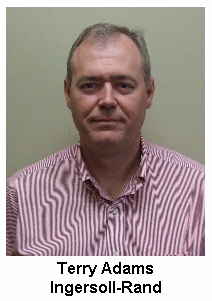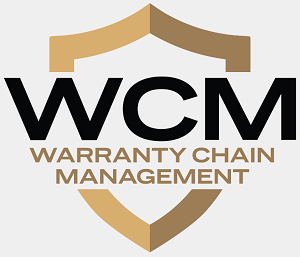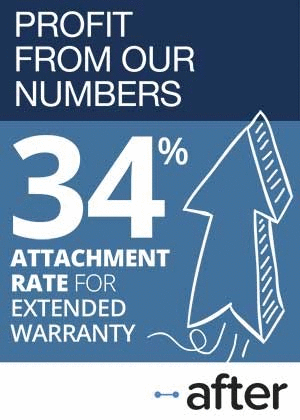February 20, 2009 |

|
ISSN 1550-9214 |
Warranty Experts:It's one thing to hear software salesmen talk about the benefits of their products. It's something else when that company's own customers stand up and say how happy they are, despite the challenges they had to overcome. And when warranty professionals gather next month in Orlando, multiple warranty experts from major manufacturing companies will do just that. One of the great advantages of attending the Warranty Chain Management Conference is being able to hear actual warranty professionals from real companies talk about the experience they gained while upgrading their warranty processing software. This year, even some of the software vendors are joining the trend. Rather than trying to sell their solutions themselves, at least two vendors are bringing along some of their actual customers to talk about the actual benefits and possible pitfalls of warranty data processing. In a round of pre-conference phone calls, Warranty Week talked to warranty professionals implementing software packages from 4CS Inc., PolyVista Inc., SAS Institute Inc., Snap-on Business Solutions, and Tavant Technologies. And while all reported some challenges to overcome along the way, all said they thought the benefits were even greater. And that's a message they are eager to share with their colleagues next month in Orlando. Text Mining PioneerJosh Becker, manager of reliability at Sub-Zero Inc., is going to detail how well text analysis has worked over the past five years. In fact, it's worked so well that Sub-Zero eventually needed to add in a module to help it manage all the issues the analysis uncovered.  Sub-Zero was one of the earliest users of the SAS Warranty Analysis package sold by SAS Institute Inc. And, it was one of the first to use that package's text mining capabilities back in 2003. "One of the things I found right away was that the analytics combined with text mining did a great job of finding issues," Becker told Warranty Week by phone. "But then the next problem that I had was how do I manage all these issues? I wanted to get away from all these Excel spreadsheets that we had years ago when we were reading claims. Well, now I had Excel spreadsheets that were piled full of issues. And we had to manage these issues somehow. So I think integrating an issue management system into your overall warranty management system is a big part of taking all the strife out of understanding warranty data and getting right to implementing countermeasures and corrective actions." Becker shares the stage on Day Two of the WCM Conference with David Froning, SAS product manager for warranty solutions. Their presentation, "Maximizing the Value: Integrating Data and Text Analysis," is part of Track 15 on Thursday from 1:00-2:45pm. "The real goal that I've had since we purchased SAS years ago was to use the textual data that we had, and the nuggets of good information there, to drive reliability improvement projects, warranty cost reductions, and fraud prevention," Becker said. Too Much Information?Initially, he used the text miner to cluster claims, and eventually added modules for service parts and fraud detection. Then, as he delved deeper into analytics, he found that there was such a thing as too much data, too much analysis, and too many issues. A lot of false positives were generated by a small number of claims. Complex conditionals that looked for the intersection of this part replacement and that part replacement with this failure mode ended up requiring even more analysis to figure out exactly what the root cause was. "It ended up being too much information," Becker said. In the future, the models will look at parts and failure modes more independently, rather than trying to analyze them all together. That way, he said he thinks the most significant issues will continue to find their way to the top of the queue, but they'll be much more specific and won't require as much additional research to pinpoint. Now Sub-Zero is busy migrating to version 4.1 of SAS Warranty Analysis. That, Becker said, is a clear signal that it's working. Five years ago, Sub-Zero was one of the first to jump in, and there's no regrets. "We took the leap and it paid off," Becker said. But would he do it all over again now? "Quite honestly, if I was going to my executive team and board of directors right now, trying to launch this for the very first time, I think I would have a lot harder time convincing them than I did back in '03," he said. "But we didn't buy this system on a whim. The key is a very solid proof of concept process." Back in 2003, SAS was able to run real Sub-Zero warranty data through a mock system, demonstrating how much sooner specific issues would have been identified had SAS Warranty Analysis been in use at the time. And the amount of saved time, he said, could be translated directly into dollars that could have been saved. That "what if?" exercise helped sell the system back then, and the actual cost savings calculated since then have helped Sub-Zero continue to cost-justify the upgrades. "We've seen a very large return on investment with that first purchase," Becker said. "Economic times right now are pretty tough," he added. "Yet we're still going through with this 4.1 upgrade. And it's not a free upgrade by any means. There's a lot of development and a lot of dollars associated with it. Our executive team and board of directors has stood behind it because for the past five years, I've come to the board meetings every year and shown them ROI examples that are big-dollar items." Warranty on the WebFrank Kozlowski, a warranty specialist at Kohler Co., plans to share the experience he gained implementing a new Web-based warranty claims processing system for use by the company's numerous engine and outdoor power equipment dealers. His presentation, with the straightforward title of "Designing and Implementing a Web-based Warranty System," will be part of Track 8 on Wednesday from 3:45-5:30pm. "I'm not going to tell everybody exactly what they have to do," Kozlowski said. But he will tell them a little about "the trials and tribulations" that he went through at Kohler, managing a nearly three year long migration from a homegrown IBM AS/400-based warranty management system to a Web-based system designed by Snap-on Business Solutions. The process began towards the end of 2005, and the Web-based system finally went live in September 2008. "I want to share my experiences and the knowledge that we gained in this process," Kozlowski said. Dealers, he said, had grown accustomed to logging into Kohler's AS/400 on their old-style green screen terminals and following a tried and true format for warranty claims that was in use throughout the outdoor power equipment industry. Then along comes the new Web-based system, not only asking for more information than before, but also validating individual fields and prompting for missing information before acceptance. "It was a big step," he said. "In the beginning, there was some push back." Some of the company's 10,000 dealers were not too computer-literate, and had trouble setting up their new user accounts, Kozlowski reported. Others were unfamiliar with Internet Explorer and Web forms. "But we've gone through that," he said, "and it has now stabilized, where people now are reporting back to us on how faster it is. They're reaping the benefits of it: how fast the information can come in, how fast we can turn it around, and how fast they can get paid." Cutting Claims Turnaround TimeOn the old AS/400 system, the target was to process 90% of all claims within 15 calendar days. "Now, we're down to two days," Kozlowski said. Fewer claims are rejected because of missing or incorrect information, and Kohler's staff has fewer follow-up questions for the dealers. For Kohler, he said, the major benefit is better relations with dealers and customers, because the system is so much more efficient at processing and paying claims. But that also means that Kohler is getting more accurate failure data faster than before, so that gives it a much better picture of emerging problems within the product line. "The main issue in implementing a new warranty system is communication," Kozlowski said. "We thought we were having good communication, yet it wasn't good enough." Early on, he now believes, there were some misunderstandings caused by people not being specific enough about what they wanted or what they could provide. And those misunderstandings did not manifest themselves until later. Kevin Krakora, director of product services at Mitsubishi Caterpillar Forklift America, plans to update WCM attendees on a warranty automation project that had just gone live two years ago when he last spoke at the conference. He's part of a three-way presentation (Track 16, Thursday 1:00-2:45pm) entitled "Innovate in the Service Chain: Innovate, Adapt, Advance" that will also include Jim Ramsdale of Mahindra USA and Gary Serbousek, a product manager at their software vendor, 4CS Inc.  "What I was planning to cover this time is what we have done with the system since then," Krakora said, "and how we're getting more from the investment and how we've expanded the lifecycle management philosophy to allow the system to do more of the work for us, instead of having manual processes." Most notably, towards the end of last year his company has added both supplier recovery and extended warranty modules to the basic 4CS iWarranty package that it had been running since 2007. This has further automated the whole warranty process, helping the company recover money faster from its suppliers and allowing its dealers to sell more extended warranty contracts with more flexible terms and conditions than before. "One of the reasons we picked this system is because of all the different modules that they had already been working on. They were a good fit for where we wanted to go long term. We started with what we considered to be the core of the system, and we've been building onto it from there," Krakora told Warranty Week. Automating Supplier Recovery"With the supplier recovery module, we're getting rid of a lot of manual steps, just like we did with our claim process. The system is getting pre-loaded with our supplier contracts, as we work through the system with each supplier. It basically takes a dealer claim that has the terms that we use to reimburse dealers, and it converts that claim to the terms of the contract with the supplier." Krakora said that some of the items that need to be converted include differences in the duration of the supplier warranties versus the end user product warranties, supplier parts prices versus dealer parts pricing, and payment terms for suppliers versus dealers. But, he added, there's little delay caused by these translations. "It converts the claim at the same moment that we approve the claim to the dealer," he said, "so that a supplier can go online to our Web site and adjudicate the claim right there, or we can provide a download service that gets them an Excel spreadsheet or something they can pull into their own business system." In the past, the process was very manual and time-consuming, with the company creating some kind of parts summary once a month, and sending that off to each supplier. That led to a protracted negotiation and finally a payment. Now it's more or less automatic, just like the adjudication of the initial claim. With the addition of the extended warranty module, dealers can speed up that process as well, making the jump from the U.S. mail to the online world. This makes it easier to price and sell a service contract, and also makes it easier to customize. "In the past, whenever they got a customer to agree to purchase an extended warranty, dealers would have to pick from our price list and fill out a paper form, and mail us a check, separate from their purchase for a vehicle," Krakora said. "Now, dealers can go online at any time and select from the warranties that are available for a particular serial number, and it automatically bills it to their dealer account once they fill out the required information. And they get a warranty with very little hassle." Flexible Extended Warranty TermsBecause of that added flexibility, he added, dealers are now also able to offer extended warranties that more closely match the durations of non-standard financing arrangements, for example three years and four months. In the past, dealers would have had to choose either three or four year terms. Krakora said there have been some technical issues over the past two years that needed to be worked out regarding formats and interfaces between all the servers and databases. "But from a business perspective, iWarranty is helping me run the business significantly better than I was able to before," he said. One big reason he cites is that the people at 4CS seem to understand his business and how it operates. "We weren't just talking to a software programming company," Krakora said. "4CS had gone to some lengths to employ people that had experience in the warranty world." For instance, the business analyst initially assigned to his account used to work at John Deere. "So we didn't have a hard time trying to convince 4CS of what our needs were, because they understood them." Plus, the system has paid for itself, Krakora added, just like it was supposed to. "When we looked into the project, we thought we could get a less than one year return on our investment," he said. "We were in fact able to do that, between our costs going down for the processing of warranty and the better data that we're getting, the cleaner claims. Putting all these things together -- average claim cost going down, improvement in quality because we were better able to communicate what the issues were in the field, and then a reduction in manpower to process all the claims -- it makes for a pretty good business case for why you need to make these kinds of investments." Askoh Kartham, CEO of 4CS, said that cutting the cost of claims entry and claims processing has to be a basic goal of any warranty management system. "But we want to enable our customers to go beyond that," he said. "There is a good revenue opportunity in extended warranty, so many customers have implemented that." And many OEM customers have also chosen to implement the supplier recovery module to reduce their own costs, he said. Now they're adding service intelligence modules to expand their understanding of interactions with the customers that take place outside of warranty or extended warranty. Pay-As-You-Go PricingAt the same time, he concedes that even if prospective customers believe the benefits are real, they still may not be able to buy. And so, he said 4CS is now looking into ways to reduce the up-front price of iWarranty and the other modules, perhaps by adopting a pay-as-you-go pricing model or an on-demand pricing model. In fact, he said he'd even be willing to discuss some kind of arrangement where the price is somehow linked to the amount of money saved. "We're willing to link some of our revenues to them realizing these gains we are saying they would get," he said. Ingersoll-Rand is actually sending two people to participate in Track 4, the panel discussion that takes place on Wednesday from 1:30 to 3:15pm. Terry Adams, from Ingersoll-Rand's Industrial Technologies Sector, and John Hagen, from Ingersoll-Rand's recently acquired Trane Commercial Systems business unit, will each speak about developments within their warranty departments.  Terry Adams, IR's director of technical services and reliability, has entitled his presentation "Harnessing and Coordinating Warranty Best Practices in a Global Diversified Enterprise." Adams said that because Ingersoll-Rand is such a diverse collection of operating companies spread all over the world, and because some of those companies are recent acquisitions that may have had their own way of doing things in the past, senior management decided several years ago to create what amounts to a standard "business operating system" that harnesses all the best practices of the different parts of the company. Initially, the big problem was that the different sectors, divisions and subsidiaries of the company were running independently and never really needed to talk to each other. Everything was in a separate silo. Therefore, he said, the first step was to get people communicating. Several enterprise focus areas and councils were launched, initially to get people such as warranty managers to meet their counterparts across the company, and subsequently to get them to talk about the best practices they'd found. Adams eventually became part of IR's Warranty Council, which now includes 13 or 14 subject matter experts from across the company, who have been meeting in person or by Web teleconference roughly once a month since late 2006. One of their first tasks was to figure out where each of the company's units was on a maturity scale, based upon a dozen different attributes. Then they began to figure out how each unit was going to move further along the maturity scale. One decision the group made was to standardize the entire company on the Tavant Technologies Warranty & Repair Management software platform. Not all parts of the company are using it yet, but they're all heading in that direction, Adams said. Another decision was to standardize the way warranty professionals are trained, tying it into the maturity scale so people are aware of what comes next. For instance, people who are new to warranty and who are just beginning to understand the reasons behind the automation of claims processing might be told about the tools surrounding supplier recovery, long before they're ready for that module to be deployed within their business unit. But at least they'll know it's coming, and why it's useful. Reliability Culture"The ultimate goal is to drive warranty down," Adams said. "But the real goal is to drive brand image, product reliability, and all those kinds of things forward. In a nutshell, I'm going to show how you can do that, even if you have a big diverse organization like us. Here's what we're doing, and we think this is a logical approach."  John Hagen, Trane's global quality leader, has entitled his presentation "Measuring and Improving an Effective and Efficient Warranty Process." He's now part of IR's Quality Council, and people reporting to him are now part of the Warranty Council. There are eight people on the Quality Council, Hagen said, which meets roughly twice a month through Web teleconferences and in person about three times a year. One of those meetings occurred this week, and one of the big topics of discussion was how the Quality Council would interact and share information with the other councils. "It's important that we're all marching in the same direction, and trying to leverage each other," he said. In Orlando, Hagen will detail how Trane has always approached warranty claims processing as just a part of an overall process that has multiple interconnected parts. For instance, a new claims processing system might reduce per-transaction costs, but it might also reduce the flow of early warning data or it might reduce the ability to detect and prevent fraud. "What we're really tried to do is balance that," he said, "so you can get effectiveness in terms of cost, speed, and efficiency." Otherwise, he suggested, money saved in one area might be spent in another area. Or the insistence on a single inflexible policy could result in bad data that ultimately drives bad behavior that ultimately wastes time. Hagen said he learned that the hard way years ago when Trane first began to re-examine its quality and warranty policies. Garbage In, Garbage Out?"We had policies where people in the field were almost incented to give us the wrong information on a claim so that they could do what was right for our customers," Hagen said. For instance, when repairs took longer than was specified by an inflexible policy, field technicians would sometimes add new reason codes to the paperwork just to increase the labor total to the actual time spent. Otherwise, the claim would be denied and that would set off months of arguing between the field office and the plant over who should pay for the additional labor. It wasn't quite fraud -- the technicians had really done the hours and would be paid no matter whose budget it ultimately came out of -- but the whole process was misleading and time-wasting. When people at headquarters would then look for trends in the repair data, they would spot trends that weren't real, because the data wasn't reliable. Hagen said all Trane needed to do to get better information was to change how it administered its policies, "to get trust at the right level." "In our first year of really going after this, we dropped warranty and concession as a percent of sales by six-tenths of a point," he said. "And I'd attribute half of that to getting the policies right and administering them better. Then we got better information to people so we could fix the right things. And then we moved on and got better analytics on it, so we could dig a little bit deeper." Some companies, Hagen said, treat warranty as merely a financial process where costs need to be cut. What he's suggesting is that it's much more than just the transfer of money. It's also a transfer of information that ultimately can boost reliability, quality, and brand image, if it's done efficiently and effectively. Hagen said that one of the first things he did when he came on board at Trane six years ago was to review warranty accrual and reserve policies that in some cases hadn't been changed in decades. "And we were able to take a lot of cash off the balance sheet, and take it to profit, at a time that it was needed as well," he said. He also helped to modify the way deferred revenue from extended warranty sales was recognized, so that it more closely matched actual claims payouts over time. "We just put a little science into it." This year, that science is going to be tested repeatedly, because of an unprecedented number of new product launches planned by the company. Because of a change in the type of refrigerant its products use, Trane is going to launch more new products this year than it has ever before. Hagen said that's going to make it even more crucial for its field systems to return accurate failure data even more quickly. In some cases, they may not even wait for claims. They've already begun analyzing incoming calls for an even bigger head start on emerging issues. "Early warning detection of new problems is just key to me," he said. Now he has the experience and expertise of all the other IR business units to leverage, thanks to the acquisition that closed last June. Back in the days when American Standard was the company's owner, Trane was allowed to more or less go its own way. Now, it's part of all these councils where collaboration and information sharing are priorities, and it has to follow the whole company's "business operating system." And on balance, Hagen said, it's going rather well. "I've been through several mergers and acquisitions," Hagen said, over a career that includes time spent at 3M, Allied Signal, Iomega, and others. "I've been on both sides. And this has been the friendliest one that I've ever been a part of." He said Ingersoll-Rand has already made great strides in the way it globally harmonizes its efforts and sets specific goals, and now Trane is becoming a part of that "reliability culture." | ||||||||||||||||||||||||||||||||||||||||||||||||||||||||||||||||||||||||||||||||||||||||||||||||||||||||
| ||||||||||||||||||||||||||||||||||||||||||||||||||||||||||||||||||||||||||||||||||||||||||||||||||||||||








